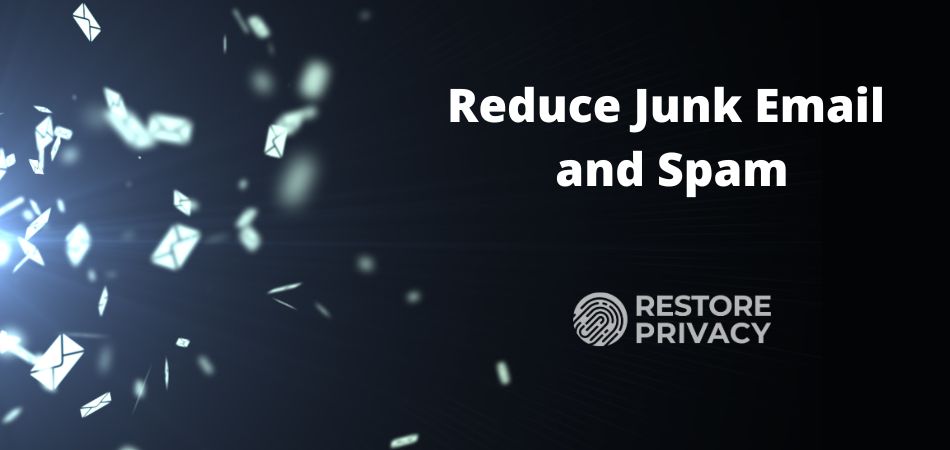
Are you feeling swamped by a relentless wave of spam and junk emails that keep invading your inbox? If yes, it’s high time to reclaim your digital space. This step-by-step guide provides smart strategies and practical tips to significantly reduce spam and junk emails in 2024. By making use of these methods, you can maintain an organized, secure inbox. Also, you’ll significantly lower the risk of falling victim to cybercrimes.
In recent years, especially since the onset of the pandemic, cybercriminals have been busier than ever. The number of cybercrime victims has nearly doubled since 2019, and spam emails are one of the favorite tools in a scammer’s arsenal. These unwanted messages are not just annoying – they can be downright dangerous.
Why, you ask? Well, each spam email you receive carries a potential threat. It could be a phishing attack where scammers trick you into giving out personal information. Or it could contain malicious attachments. When opened, these can install malware on your device, putting you at risk of identity theft.
So, reducing the number of junk emails you receive isn’t just about convenience or maintaining a clean inbox. It’s about safeguarding your personal information and reducing the risk of becoming a cybercrime statistic.
So, let’s roll up our sleeves and get to work on minimizing those pesky junk emails.
Key Takeaways
- Adjust your spam filter and establish custom rules to manage unwanted emails efficiently.
- Keep your passwords strong and your security measures robust. You might also want to think about switching to a more secure email provider to further guard against spam emails.
- Learn to spot the usual scams and threats. Always check if the sender is who they claim to be before engaging with them.
- Utilize data removal services like Incogni to get your information (and email addresses) removed from data broker sites
Why am I getting so many spam emails?
Ever wondered why your inbox is being bombarded with spam emails? There could be several reasons for this:
- A spammer’s database might contain your email address. This can occur if someone scraped it off the internet, a third party sold it, or it leaked in a data breach.
You might have unwittingly signed up for services online using your email address.
You may have responded to phishing messages.
- Sharing your email address on social media or other public platforms might have made it an easy target for spammers.
- You might have participated in an online survey or contest that required you to provide your email address. Afterward, someone might have sold it to third parties.
These are the most common reasons behind the annoying influx of spam emails. However, don’t worry, there are ways to combat this.
One simple step is to mark spam emails as spam in your email client or report them to your email provider. This helps improve their spam filters. Also, using strong passwords and taking other security measures can help keep your account safe, reducing the chances of getting more spam emails in the future.
Ultimately, safeguarding your personal data goes beyond mere confidentiality. It’s about asserting control over your information, managing its access, and actively choosing the extent of sharing or even deleting aspects from the digital landscape, including the option to delete yourself from the internet.
What’s the difference between junk email and spam?
Now, you might’ve heard the terms “junk email” and “spam” being tossed around quite a bit. They’re often used interchangeably, but there’s actually a bit of a difference between the two.
Junk email is usually what we call those unwanted promotional messages that find their way into our inbox. You’ve definitely come across these – newsletters, offers, and advertisements that arrived without your request or that you’ve simply lost interest in. Legitimate businesses usually send them and, if you’re fortunate, they’ll provide an option for you to unsubscribe.
On the flip side, spam is the name we give to unsolicited bulk messages that could be a bit more dangerous. Often, unknown or suspicious senders send spam to a massive number of recipients. These could include phishing attempts, scams, and messages carrying viruses, malware, and other cyber threats that we definitely don’t want to deal with.
Telling the two apart can be pretty simple. Junk emails are often from familiar sources, like retailers or services you’ve used before, and they’re usually trying to sell you something. Spam, however, often comes from unknown senders, might have vague or misleading subject lines, and the content can seem a bit sketchy, often urging immediate action or offering something that seems too good to be true.
What dangers come with receiving unwanted emails?
Wondering why you should even bother about the swarm of unwanted emails that flood your inbox? Well, each one of these emails carries a potential threat. Phishing attacks pose a threat as they aim to trick you into divulging personal information. Additionally, malicious attachments, once opened, can install malware on your device. Think of it as inviting potential troublemakers into your home.
These unwanted emails aren’t just an inconvenience. They represent a serious risk to your online security. They can lead to identity theft, financial loss, and a whole lot of stress. So, it’s not just about reclaiming your inbox from the clutches of spam and junk. It’s about protecting your digital life from the harmful effects of these unwanted intruders.
11 effective strategies to reduce junk email and spam
Alright, we’ve covered the reasons behind the flood of spam emails in your inbox and we’ve differentiated between junk email and spam. Now, let’s delve into 10 effective tactics to halt these bothersome messages. Implement these strategies, and you’ll take back control of your inbox, filling it only with the emails that matter to you.
Here’s what we’re going to do:
- Teach your email provider’s spam filter what you like and don’t like.
- Start using email aliases or throwaway addresses. (Check out StartMail for unlimited email aliases.)
- Use a data removal service like Incogni to remove your data (and email addresses) from third-party data broker sites (with a 55% off coupon).
- Say goodbye to unwanted mailing lists and newsletters.
- Set up your own filters and rules.
- Keep your main email address under wraps.
- Report phishing and scam emails
- Block those spam senders who just won’t quit.
- Bring in third-party anti-spam tools.
- Keep your passwords strong and your security measures even stronger.
- Think about switching to a more secure email provider.
With these strategies up your sleeve, you’re ready to take on junk email and spam, making your email experience cleaner, safer, and more organized. Additionally, you’ll be equipped to manage and even delete your digital footprint, enhancing your online privacy.
1. Train your email provider’s spam filter
Your email provider’s spam filter, which is a part of your mail app, is your first line of defense against unwanted messages. By training this filter, it can identify and block spam emails more effectively.
You can train your spam filter by marking spam messages and reporting them to your email provider. When you mark an email as spam in your mail app, the filter learns which messages should be classified as such, improving its accuracy over time.
The method of marking an email as spam can vary, depending on your mail app. For example, this process may look different in Gmail, Yahoo Mail, Outlook, and Apple Mail. Reporting spam emails not only benefits you but also contributes to improving spam filters for the wider user base.
2. Use email aliases or disposable addresses
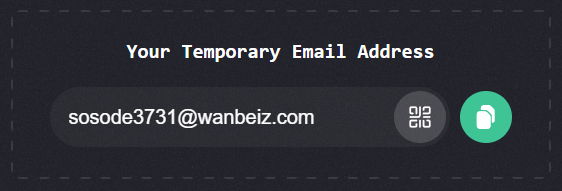
Think about using email aliases or disposable addresses like wearing a disguise for your email. It’s a clever way to keep your main email address hidden from spammers and helps you keep your privacy intact. So, when you’re signing up for a newsletter or online service, consider using an alternative email address. By doing this, your main email address stays incognito, cutting down on the amount of spam you receive.
There are a bunch of handy tools and services out there, like the Burner Emails extension, the Screener feature from Clean Email, and the Temp Mail that offers free, self-destructing temporary emails, that let you create temporary email addresses. The best part? You can turn off these disposable addresses whenever you want, blocking any unwanted messages. Just remember to update your email address with important contacts and services when needed so you don’t miss out on the messages you actually want to see.
Ever heard about doxxing? It refers to the malicious act of publicly revealing an individual’s private or sensitive information, such as their email or home address, with the intent to harass, threaten, or invade their privacy. Preventing doxxing involves understanding how to avoid the exposure of personal information, shielding yourself from potential attacks.
3. Use a data removal service to get your information (including email) off third-party data broker sites
Ever felt like your personal information is floating around in the digital universe without your permission? If so, you’re not alone. The good news is that there are ways to reclaim your privacy and keep your data off the market. This involves data removal, and there are two main approaches to this: do-it-yourself (DIY) or using third-party services.
If you’re a DIY kind of person, you can manually search for your information on various data broker websites and request removal. This can be time-consuming and requires a lot of patience, but it’s definitely doable.
On the other hand, if you’d rather someone else do the heavy lifting, third-party services like Incogni and DeleteMe can come to your rescue. They take the hassle out of the process and do all the hard work for you.
In short, although you can tackle it on your own, opting for one of the top data removal services proves to be a swifter and more efficient choice.

How data removal services work
Let’s take a closer look at how services like Incogni and DeleteMe work. They start by listing data brokers likely to have your information. This could include sensitive details like your social security number, physical address, phone number, and email address.
Why should you care? Well, this data can be used for a variety of purposes. It can be used for marketing, recruitment, financial, and health purposes. It can even be used for further scams and phishing attempts. This could result in unwanted ads, influence your loan eligibility or insurance rates, and increase the risk of cyber attacks.
Once services like Incogni and DeleteMe have a list of potential data brokers, they send out removal requests to delete your personal data. But the job doesn’t stop there. Even after deleting your information, brokers are still being sent data removal requests regularly. This is because they have a tendency to collect the person’s information again after some time.
As an Incogni user, you can monitor the entire process on your Incogni dashboard. This includes potential databases found, requests sent and requests completed. It’s a convenient and effective way to keep your personal information private and secure. Plus, for a one-year subscription, offered at a 50% discount ($7.49 per month), Incogni will keep your data off the market.
On the other hand, if you’re looking for a more premium, all-inclusive service, you might want to consider DeleteMe. While it’s pricier, with the cheapest plan costing $10.75 per month, DeleteMe offers a comprehensive suite of features to ensure your personal data is well-protected and kept off the internet.
All in all, whether you choose to go the DIY route or use a third-party service, the important thing is to start taking back control of your personal data. After all, it’s your information, and you should have the final say on who gets access to it.
Dive into our comprehensive Incogni review for more information about their services. On the other hand, if you’re considering its rival, don’t miss our in-depth DeleteMe review.
To explore Incogni’s performance in comparison to similar services, explore our comparison guides, Incogni vs DeleteMe and Incogni vs Privacy Bee.
For individuals seeking a user-friendly interface and comprehensive removal reports, our Optery review and our Privacy Bee review offer valuable insights.
4. Unsubscribe from unwanted mailing lists and newsletters
Unsubscribing from those pesky mailing lists and newsletters you no longer want is a super simple way to cut down on the clutter in your inbox. Most of these emails come with an unsubscribe link tucked away at the bottom of the message. Clicking on this link means you can wave goodbye to future emails from that sender.
However, you need to be a bit careful when unsubscribing from spam emails. Some scammers use fake unsubscribe links that can lead you to a dodgy website or even download malware onto your device. To dodge these dirty trick, only unsubscribe from emails sent by companies you know and trust, and make sure the unsubscribe link looks legitimate before you click on it.
5. Set up custom filters and rules
Custom filters and rules in your email client act as a critical line of defense, deciding which emails are permitted access to your inbox. Creating these filters allows you to automatically sort and manage incoming emails, sending those unwanted party crashers to designated folders or even straight to the trash bin.
Now, how you set up these filters and rules can vary based on your email provider. Most of them, like Gmail, Outlook, and Yahoo Mail, have built-in tools and settings that let you create filters based on specific criteria. You can set rules based on the sender’s email address, certain words in the subject line, or even keywords in the email content.
By fine-tuning these filters and rules, you’ll keep your inbox neat, tidy, and free from unwanted email clutter.
6. Keep your primary email address private
Keeping your primary email address a secret is a smart move when it comes to cutting down on spam and junk emails. The less your email address is exposed online, the less likely it is to end up on a spammer’s hit list.
Think about setting up a sidekick email address, also known as a secondary email account, for things like online registrations, subscriptions, and purchases. This way, your main email address stays safe and secure. Plus, if your secondary email address gets bombarded with spam, your main inbox remains a peaceful, spam-free zone.
7. Block persistent spam senders
Blocking those annoying spam senders who just can’t take a hint is another handy trick to keep their messages from cluttering your inbox. Most email clients, including our good old Outlook, offer an option to block specific email addresses. Once blocked, any future messages from these senders are automatically marked as spam and kept out of your inbox.
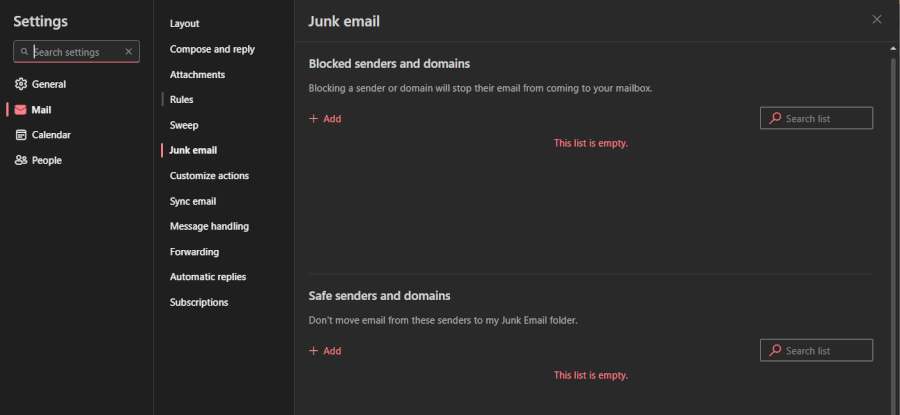
Here’s how you can block persistent junk mail senders on Outlook: Simply right-click on the junk mail, navigate to Junk, and then click on Block Sender. And just like that, your inbox will be free from further emails from that sender.
By blocking these persistent spam senders, you’re effectively putting a stop to their unwanted messages, making your inbox a much happier place.
8. Report phishing and scam emails
Phishing and scam emails, often called spam emails, are cunning attempts to trick us into sharing personal information or money by pretending to be legit companies or services. Reporting these emails to your email provider and employing a third-party spam filter isn’t just about keeping your own inbox clean – it helps improve spam filters for everyone else too.
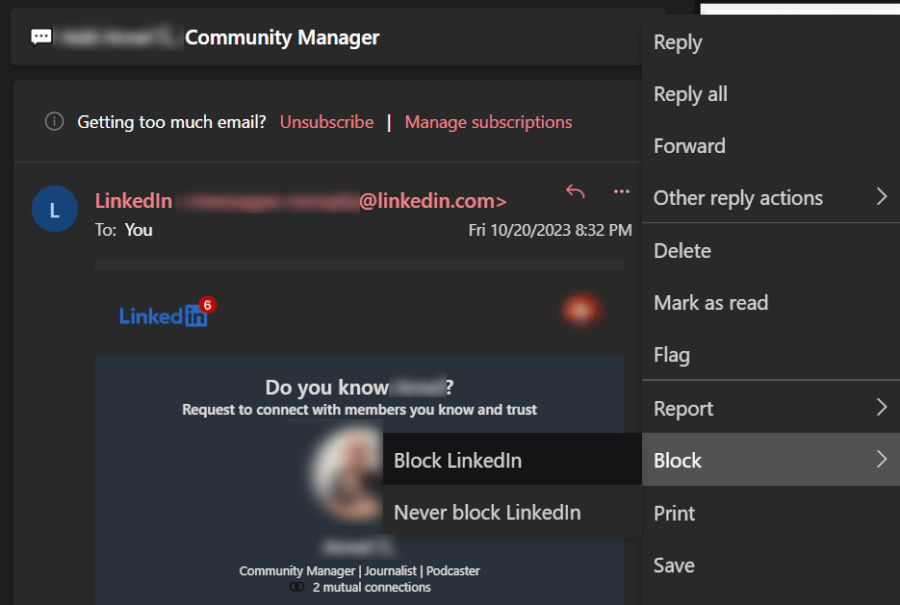
To report these pesky phishing and scam emails, all you need to do is mark the message as spam or use the built-in reporting tools in your email client. For instance, in Outlook, you can simply select the suspicious email, go to the Junk menu, and select Report as Phishing. This helps your email provider to spot and block these sneaky senders, making it less likely you’ll get future spam and helping to protect other users from falling for scams.
9. Use third-party anti-spam tools
Third-party anti-spam tools can be a real game-changer when it comes to warding off spam and junk emails. They work like a supercharged extension of your email provider’s built-in spam filters. They’re like a bouncer at the door of your inbox, sizing up every incoming email, deciding who gets in and who gets the boot. Here’s how they do it:
Content filtering: The tool scans the content of each email and if it spots any typical spammy language or suspicious links, it’s a no-go.
Blacklisting: This is essentially the online version of a ‘No Entry’ list. If the sender’s email address is on this list, their emails won’t make it to your inbox.
Whitelisting: On the flip side, this is the VIP list. Senders on this list are always allowed in your inbox. It’s a great way to ensure emails from your favorite contacts never get marked as spam.
Machine learning: This is where the tool learns from your preferences. Over time, it gets smarter at identifying what you consider spam, making it more effective.
These techniques work together to identify and block spam emails, ensuring your inbox remains a spam-free zone.

There are several third-party anti-spam tools out there that you can try, such as MailWasher, Spam Bully, and SpamSieve. They can be easily integrated with your email client, and they work tirelessly to keep your inbox clean and organized. Think of them as your personal inbox bodyguards, keeping you safe from spam and junk emails.
If you’re weary of your personal details floating around on Whitepages, our comprehensive guide offers step-by-step instructions on opting out of Whitepages, ensuring your data is removed from their database.
Similarly, if you’re fed up with incessant robocalls, our comprehensive guide on stopping spam calls and robocalls offers effective solutions to put an end to this persistent annoyance.
10. Maintain strong passwords and security measures
Creating robust passwords and implementing strong security measures is your key to fortifying your email account against spammers and hackers. Regularly refreshing your password and using a complex mix of letters, numbers, and symbols can fortify your account against unauthorized access.
Think of your password like a lock on a door – the more intricate the lock, the harder it is for intruders to break in. A strong password is like a high-security lock – it could be a random string of letters (both uppercase and lowercase), numbers, and symbols, and ideally, it should be at least 12 characters long.
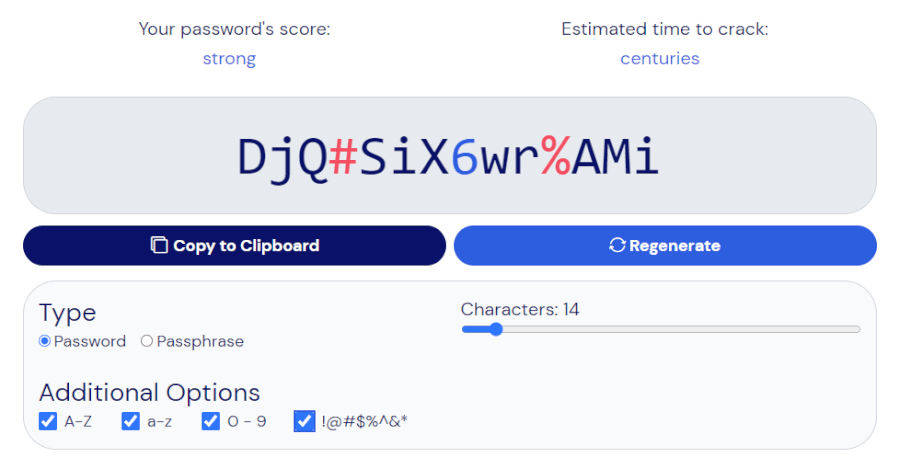
Now, coming up with a new, ultra-secure password every time can be a bit of a headache. That’s where password generators like Bitwarden come in. So, Bitwarden not only stores all your passwords securely but also generates high-security, random passwords that are tough for hackers to crack.
In addition to strong passwords, enabling two-factor authentication (2FA) for your email account can provide an extra layer of security. This is like adding an additional lock to your door. Even if someone manages to crack your password, they’d still need to bypass the 2FA, making it doubly difficult for them to access your account.
By implementing these security measures, you’re reducing the risk of your email account being compromised and, consequently, decreasing the likelihood of receiving spam emails.
If you’re interested in superior password security, be sure to give our guide on the top password managers a read.
11. Consider switching to a more secure email provider
If you’re finding that your current email provider isn’t quite cutting it when it comes to filtering out spam and junk emails, it might be time to think about switching to a more secure provider. These providers come with advanced spam filtering capabilities and privacy features that can make your email experience a lot smoother:
ProtonMail: Known for its strong emphasis on privacy and security, ProtonMail offers end-to-end encryption to keep your messages safe from prying eyes.
- StartMail: StartMail is a premium secure email provider based in The Netherlands. It offers robust encryption, unlimited email aliases, and works well with third-party email clients.
Mailfence: It’s a secure and private mail service that offers end-to-end encryption, ensuring that only you and your recipient can read your messages.
Posteo: With a strong commitment to sustainability and privacy, Posteo offers a completely anonymous way of sending and receiving emails.
Zoho Mail: It’s a secure and reliable business email solution tailor-made for your organization’s communication needs.
By switching to a provider that prioritizes your security, you’ll be better equipped to delete spam and keep your inbox free from unwanted emails. Plus, you’ll enjoy a cleaner, more organized email experience.
If you’re interested in safeguarding your digital communication, check out our comprehensive guide on private and secure email services to help you choose the best option for your needs.
How to future-proof your inbox
Now that we’ve covered how to clean up your current email situation, let’s look at how you can protect your inbox in the future. Here are some simple, yet effective steps you can take:
Limit the distribution of your email address: Be cautious about who you give your email address to. The less you share it, the less likely it is to end up in the hands of spammers.
Create a secondary email address: This is a great way to keep your primary email address safe. Use this secondary address when signing up for newsletters, online services, and other subscriptions.
Be cautious with links and attachments: If an email seems suspicious, don’t click on any links or open any attachments it contains. These could potentially be harmful to your device or lead to your information being stolen.
Don’t respond to spam emails: If you receive an email that you believe is spam, don’t engage with it. Responding can confirm to the sender that your email address is active, which could lead to more spam.
Remove your email address from public view: If your email address is listed on any websites, consider removing it. Spammers often use web scraping tools to collect email addresses from websites.
By following these steps, you can significantly reduce the amount of spam you receive in the future, keeping your inbox clean and secure.
How to recognize and avoid common email scams and threats?
Common email scams and threats include phishing emails, lottery scams, and fraudulent offers. These crafty emails often try to trick users into handing over personal information or money by pretending to be legitimate companies or services. Here’s how to recognize and avoid these scams:
Check the email content: Look for red flags such as urgent language in the subject line, unexpected requests for personal information, and suspicious links or attachments.
Verify the sender: Always verify the sender’s legitimacy before engaging with their email. You can do this by conducting a quick online search to check the authenticity and reputation of the company or service.
Stay vigilant: By staying vigilant and informed, you’ll be better equipped to recognize and avoid common email scams and threats, protecting your inbox and personal information from harm.
By understanding and implementing these strategies, you can drastically reduce the number of junk and spam emails, thereby enhancing your email experience and ensuring your digital safety.
How to massively reduce junk email and spam FAQ
How can I stop receiving a large number of spam emails?
To minimize spam emails, consider training your email provider’s spam filter, using email aliases, and unsubscribing from unwanted mailing lists. Additionally, implementing custom filters, keeping your main email private, blocking persistent spam senders, and reporting phishing emails can be effective. If all else fails, consider utilizing third-party anti-spam tools, maintaining robust security measures, and possibly switching to a more secure email provider.
How do spammers get my email address?
Spammers can get hold of your email address in several ways. They might scrape it off the internet, purchase it from a third party, or obtain it from a data breach. You might also unknowingly provide it when signing up for online services, responding to phishing messages, or sharing it on social media and other public platforms.
Is it better to block or delete spam?
It’s generally better to block spam rather than just delete it. By blocking a spam sender, you prevent future messages from that sender from reaching your inbox. Deleting a spam message only removes the current message, not future ones from the same sender.
How can I identify common email scams and threats?
Common email scams and threats often come in the form of phishing emails, lottery scams, and fraudulent offers. These crafty emails often try to trick users into handing over personal information or money by pretending to be legitimate companies or services.
To identify these scams, look for red flags such as urgent language in the subject line, unexpected requests for personal information, and suspicious links or attachments. Always verify the sender’s legitimacy before engaging with their email. You can do this by conducting a quick online search to check the authenticity and reputation of the company or service.
How can I prevent spam emails on Gmail, Yahoo, and Outlook?
Preventing spam emails on Gmail, Yahoo, and Outlook involves a combination of strategies. First, make use of the built-in spam filters and report any spam emails you receive to improve the filter’s accuracy.
Then, set up custom filters and rules to automatically sort and manage incoming emails. Also, unsubscribe from unwanted mailing lists and newsletters and use email aliases or disposable addresses when signing up for online services.
Finally, maintain strong passwords and enable two-factor authentication to secure your account against unauthorized access.
Conclusion
Ultimately, taking control of your inbox is more than just a convenience—it’s a crucial step in protecting your personal information and maintaining a clean, organized, and secure digital space. Let’s recap the ten steps we’ve covered to massively reduce junk email and spam:
- Train your email provider’s spam filter to recognize and block unwanted messages.
- Use email aliases or disposable addresses when signing up for online services to keep your main email private.
- Unsubscribe from unwanted mailing lists and newsletters to reduce clutter.
- Set up custom filters and rules to automatically sort and manage incoming emails.
- Keep your primary email address private to avoid being targeted by spammers.
- Block persistent spam senders who keep sending unwanted messages.
- Report phishing and scam emails to help improve spam filters.
- Use third-party anti-spam tools for an extra layer of protection.
- Maintain strong passwords and security measures to protect your account from unauthorized access.
Consider switching to a more secure email provider if you’re still receiving a lot of spam.
By implementing these strategies, you’ll be well on your way to reclaiming your inbox from the clutches of junk email and spam in 2024. Remember, every step you take towards reducing spam contributes to a safer, more organized, and less stressful email experience. So, start today and enjoy the benefits of a clutter-free inbox.
This how to massively reduce junk email and spam guide was last updated on April 28, 2024.

How would you suggest we deal with a spammer that uses a new unique email address and domain every time they send out emails? the sending email addresses look like this: [cquHenrySantiagocqu@ihdmhgzidxq.net]
I don’t really want to abandon my email address, but it is hosted by Spectrum and they refuse to do anything about the situation. I’m getting a few hundred spam emails per week and blocking the sender or even blocking the domain is completely useless.
I would check out alternative email services and start slowly migrating to something better. I’ve been testing out StartMail lately and really like it.